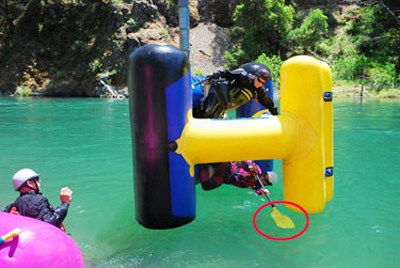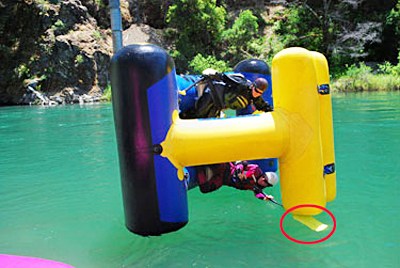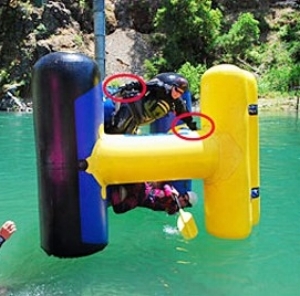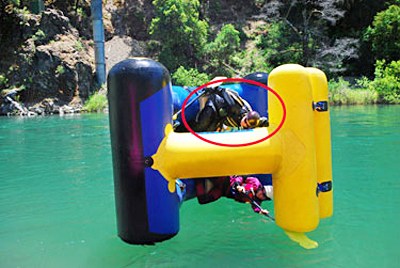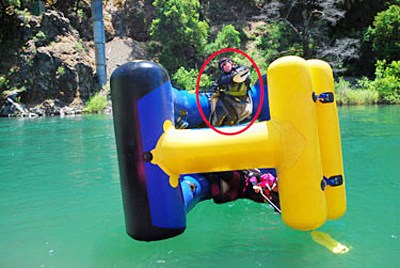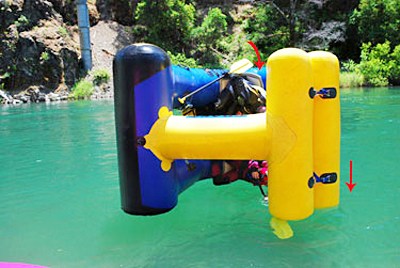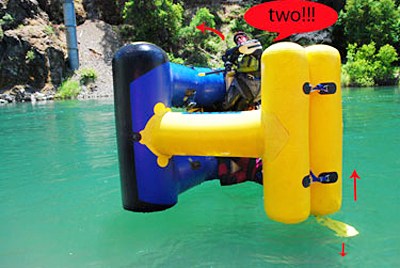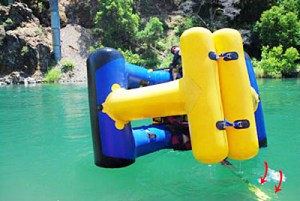How to
Roll Training 101
When a Creature Craft is on its side; the paddlers on left and right become top and bottom. At this point the team members have different jobs, but they must continue to work together to right the boat. We can’t stress how important it is for both team members must set themselves up properly in order to roll.
Setting Up the Bottom Side
When you find yourself on the bottom side of a Creature Craft, it is almost instinct to want to “pull” yourself in; bringing your weight to the capsized (inside) of the boat. To right the boat, you must make a smooth, concentrated effort to get outside the boat. The concept is to negate your weight. If you are actively hanging to the inside (i.e. grabbing opposite seat), that is exactly where you don’t want your weight to perform a roll.
In order to negate your weight, the bottom paddler must relax, and lay their upper body in the water. Remember you are weightless there; trust your PFD to float your chest.
Turn your head up and look at your partner, communicating with him or her is paramount. Once you’re weight is out of the boat, begin setting up by sculling your paddle blade so that the blade is on or near the surface and flat. (See sequence below)
If you need a visual reminder, glance at your hands and note the position of the T-grip. The fingers of your inside hand should be wrapped around the T-grip and straddling the shaft evenly – fingers facing down. Having your fingers facing down is important to confirm your paddle blade is flat on the surface. Your outside hand is still holding the shaft of the paddle a little bit wider than shoulder width apart.
Look up and align your paddle blade with the cross tubes at the peak of the boat. This guarantees your paddle is a straight extension from your body.
Setting Up the Top Side
To set up a roll from the top side, you must first position your hands. Your inside hand should be flat on the peak leg, your outside hand holds your paddle while grabbing firmly onto your seat.
Push up, using both hands and lift your body up. This will take the pressure off your thigh strap allowing you to turn your body.
Remove your feet from the foot cups and as you rotate your body to the inside of the craft, place your feet on the edge of your partners’ seat with your knees slightly bent.
Coordinating Top & Bottom for Effective Roll
At this point, both paddlers, top and bottom, are set up to right the boat. It is important to remember both verbal and non-verbal communication is crucial when performing a roll.
An advantage the top paddler has is the ability to look downriver and see not only what hazards exist, but also what river features may be beneficial to your roll such as a wave or hydraulic. Communicate with your partner when attempting your first roll. Planning ahead on your count helpful to count and “go on 2”. The top side person is the counter.
When attempting the roll, the top side person begins tall with a high fulcrum pivoting at the waist to a 90 degree angle and “exploding” up, launching their weight to the outside of the boat’s capsule. Stay in this extended high side until the boat rolls and pulls you back to the inside.
The top side paddler’s goal is to “rock” the boat so that the cross tubes at the peak come out of the water. Sometimes the top paddler must push down on the peaks using the buoyancy of the air chamber. Differences in body types might create the need to turn their shoulders and extend their body outside the capsule of the boat a bit farther than others. This is in order to “stretch out” their weight as far as possible. It is important to commit on every attempt. Some rolls are all about patience. On the bottom, the advantage is being able to “feel (using your hips) the boat” in the seat as it begins to right itself.
If you have agreed with your partner to “go on two”, then on the count of two, you must do your part to roll. The top paddler brings their weight in and shouts “one!”, as they launch their weight out of the boat and holds it so that they keep their weight outside the boats capsule. The top side paddler’s momentum will start to lift the cross tubes at the peak out of the water. The top paddler holds this position until the boat pulls them back to the inside. Once back inside the boats’ capsule, again the top side paddler pivots 90 degrees at the waist, exploding up again while giving the second count.
On the count of two, the bottom paddler holds their breath, puts their face under and rotates their chest so that it is flat in the water. As you rotate towards the water, outstretch your arms and extend your paddle further by sliding the “shaft” hand towards the T-grip. Using both hands, put equal pressure on the shaft and blade, so that the paddle blade pushes parallel to the water surface. Push your chest down into the water slowly, feeling the resistance while keeping your arms outstretched in front of your face.
The bottom paddler must not get excited and go too quickly; relax and use the water’s resistance. Resist the urge to lift your body out of the water because you are still trying to negate your weight. It is possible to reset and try again with the same breath. Some paddlers might even get a third attempt in with their original breath, but if you haven’t rolled up yet, you will want to check in with your partner on the top side to ensure you’re still working together.
Avoid tunnel vision and rushing the issue. Stay calm and think out the process. Think clearly and remember that panicking will only waste oxygen.


